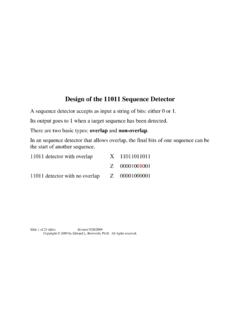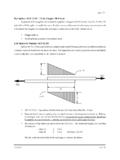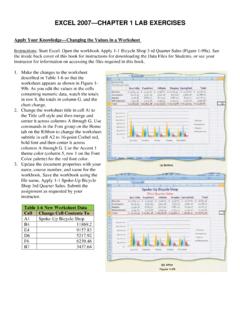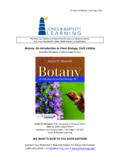Transcription of Chapter 2 – Structure of an IBM Mainframe Assembler ...
1 Page10 Chapter 2 Revised onFebruary 6, 2009 Copyright 2009 by Edward L. Bosworth, 2 Structure of an IBM Mainframe Assembler language ProgramOne of the main issues in learning Assembler language for the IBM Mainframe Series, such asthe IBM/370 and following models, is the environment in which the programming is set of notes on accessing the IBM Mainframe and creating an Assembler language program torun on that system. Much of what is said here can be applied to running other programs , such asCOBOL, on the Chapter was revised in January 2009to reflect the new IBMM ainframe to which Columbus State University was recently granted Chapter begins with a description of howto log on to our Mainframe , presents some cautionsin use of the emulator,discusses the Structure of an Assembler program that will run on the CSUmainframe, andcloses with a discussion of the use of the editor and other system reader should note that almost all of the illustrations in this Chapter are screen shots takenfrom the standard CSU terminal emulator, usingthe standard screen style.
2 Other styles can beused; the more common option being one with the background display set to black. While thisoption displays well, it does not print well. For this reason, I have chosen the style the Terminal EmulatorBefore starting our discussion on accessing an IBM Mainframe , it is important to discuss somecautions in use of the terminal emulator. There are significant differences between the use of thekeyboard for this tool and for the normal programming as done in the Terminal SessionAs noted below, the first thing to do when running a program on the Mainframe is to launch theterminal emulator on your PC and log onto the Mainframe . This establishes a session on theMainframe and allows you to edit and run is very important that you log off the Mainframe in an orderly manner.
3 It is almost always notacceptable just to close the Terminal Emulator as one would close any MS Windows programbefore logging off the Mainframe . If you do that, the Mainframe will maintain your session for atime (possibly 15 minutes to an hour) and not allow you to log back caution also applies if the session is dropped due to any other errors; bad LockAnother event that frequently happens is that the emulator will stop responding to key this point, you might see XMITLock in the display bar at the bottom of the emulatorwindow. To clear this, hit the ESC (Escape) key a numberof times. If that does not work, thenalternatively hit Ctrl Q and Ctrl S. You cannot proceed until the keyboard is of the Overwrite ModeThe normal (and preferred) mode for running the emulator is calledOverwrite, as opposed word processors can be operated in either mode, but commonly work in operating the terminal emulator in Insert Mode can yield complex and perplexing results,we note here that misuse of the Overwrite mode can lead to predictable, but wrong, the problem of altering the string AAABBBCCC to read AAADDDCCC.
4 In Insertmode, one might place the cursor after the BBB , backspace 3 times, and then insert the DDD .S/370 AssemblerStructure of a ProgramPage11 Chapter 2 Revised onFebruary 6, 2009 Copyright 2009 by Edward L. Bosworth, what happens in Overwrite Mode. First position the cursor after theBBBto getAAABBB|CCCT henbackspace three times to get the stringAAA|CCCThen enter the string DDD . The result is logical, but surprising. The new string isAAADDD|What has happened is that the CCC in the string AAACCC has been overwritten to producethe result AAADDD . The CCC was not moved over so that the string DDD could beplaced in front of it; the string CCC just replaced the next three characters in the old Cautious About Non Standard KeysHere I have a very precise definition for the non standard term Non Standard Key.
5 It is a keythat does not immediately correspond to a key on the IBM 029 card punch. Within this arbitrarydefinition, let us stipulate that lower case letters correspond to upper case letters, all of which arepresent on the IBM a few exceptions, the standard keys are those that produce printable wayto refer to this set of keys is to call them the Character Keys , though this is not a the standard keyboard, these include the alphabetical keys, the digit keys directlyabove them, the space bar (it produces the character), the shift key (which produces nocharacter), and the characters generated by pressing the shift key and one of the other mentionedkeys. This set of keys specifically DOES NOT INCLUDE the keys inthe Numeric Keypad tothe right of a standard AssemblerStructure of a ProgramPage12 Chapter 2 Revised onFebruary 6, 2009 Copyright 2009 by Edward L.
6 Bosworth, now note that most terminal emulators are not guaranteed to handle all of the standard keyscorrectly. Let us ignore the Multimedia Keys and Internet Controls (which nobody would expectto work) and discuss the other Keypadkeys emit scan codes that may differ from those emitted by the digit keysthat are at the top of the alphabetical set. These might be converted into different EBCDID codes by the terminal emulator, and thus be misinterpreted by the Keysemit codes that generally have no meaning to most terminal Control Keyscan beused in certain contexts, such as moving over text. Theyshould not be viewed as introducing a space character, though they may seem to do Keysare correctly interpreted by the emulator and passed to the following keys canbe used with the standard terminal emulator packages: the characterkeys, the Function Keys, and (occasionally) the Cursor Control Keys.
7 In general, the ControlKey, Alt Key, Windows Key, keys in the Numeric Keypad, and the Toggle Keys should these often work, they occasionally will cause the keyboard to onto theMainframeThe first step is to run a terminal emulator. What we have on the computersat CSU is called zScope Classic , currently version I double click the program starts. In the status line at the bottom of the screen and below what will become thedisplay, one sees two words: OFF LINE and Overwrite . The standard for the Mainframe isediting in the overwrite mode, in which the characters typed will replace the existing OFF LINE is an indication that one needs to connect tothe Mainframe before to the File menu at the top and click on Connect (Alt C).
8 Another option is to click on the lightning bolt icon just below the File menu. You will be connected to the Mainframe . At thispoint, you should see a splash screen with ENTER L FOLLOWED BY THE APPLID YOUWISH TO LOGON TO . Immediately we see that we have landed in UPPERCASE LAND, thestandard style for the classis Mainframe application. You might as well set the CAPS LOCK on your TSOE nter the above line, followed by a carriage return (the Enter key). You will be prompted for auser ID. I entered my seven character ID. You should usethe user ID assigned to you by theinstructor. You are taken to another screen, with the cursor positioned at the place for entry ofyour seven character this is your first use of the Mainframe , your password will be set to your user ID.
9 Youwill berequired to change the password before proceeding. Enter the password followed by a CR (hitthe enter key). DO NOT USE MORE THAN SEVEN CHARACTERS FOR THE PASSWORD,as this can lead to effects that will appear to be random, though they are this point, you will see several screens of announcements, the last one ending with LASTMESSAGE FROM . Hit the Enter Key at the end of each of these hitting the Enter Key after the last key, you will be presented withthe ISPF Primary OptionsMenu (shown below, using my display option).S/370 AssemblerStructure of a ProgramPage13 Chapter 2 Revised onFebruary 6, 2009 Copyright 2009 by Edward L. Bosworth, you use another screen style, your display will appear different, but have this a FileThere are two tasks here: find the file that you want to edit and actuallyediting chose menu option 2.
10 This takes me to a menu with a lot on it, including:ISPF LibraryProject_____Group_____Type_____Me mber_____For the project enter your user ID. This is an assembly language course, so the group is edit source code, so the Type is SRC. Since I have logged on before, the system rememberswhat I last looked at and displays as LibraryProjectCSU0003__GroupASM_____Type SRC_____Member_____This is what I want, so I hit the enter AssemblerStructure of a ProgramPage14 Chapter 2 Revised onFebruary 6, 2009 Copyright 2009 by Edward L. Bosworth, EDITS creenWhat now displays is titled EDIT . I would call it a File Listing ,though I am confident that this is not IBM terminology. I now must select a file to listing shows five lines, appearing approximately as is time to select a line and thereby select a file to be edited.










